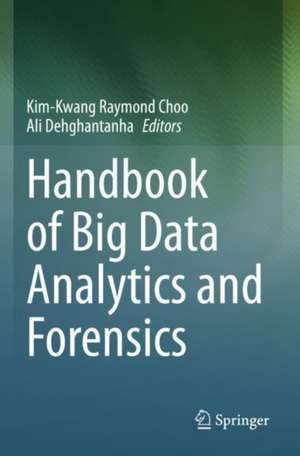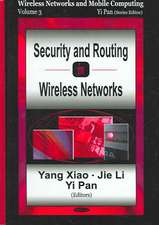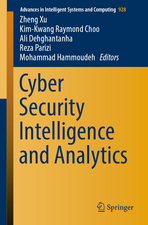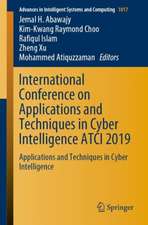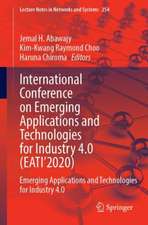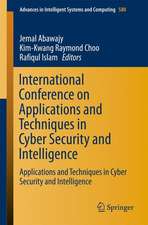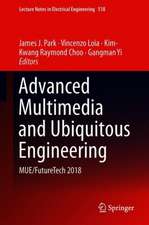Handbook of Big Data Analytics and Forensics
Editat de Kim-Kwang Raymond Choo, Ali Dehghantanhaen Limba Engleză Paperback – 4 dec 2022
The authors evaluate the performance of unsupervised machine learning for detecting cyberattacks against industrial control systems (ICS) in chapter 7, and the next chapter presents a robust fuzzy Bayesian approach for ICS’s cyber threat hunting. This handbook also evaluates the performance of supervised machine learning methods in identifying cyberattacks against CPS. The performance of a scalable clustering algorithm for CPS’s cyber threat hunting and the usefulness of machine learning algorithms for MacOS malware detection are respectively evaluated.
This handbook continues with evaluating the performance of various machine learning techniques to detect the Internet of Things malware. The authors demonstrate how MacOSX cyberattacks can be detected using state-of-the-art machine learning models. In order to identify credit card frauds, the fifteenth chapter introduces a hybrid model. In the sixteenth chapter, the editors propose a model that leverages natural language processing techniques for generating a mapping between APT-related reports and cyber kill chain. A deep learning-based approach to detect ransomware is introduced, as well as a proposed clustering approach to detect IoT malware in the last two chapters.
This handbook primarily targets professionals and scientists working in Big Data, Digital Forensics, Machine Learning, Cyber Security Cyber Threat Analytics and Cyber Threat Hunting as a reference book. Advanced level-students and researchers studying and working in Computer systems, Computer networks and Artificial intelligence will also find this reference useful.
| Toate formatele și edițiile | Preț | Express |
|---|---|---|
| Paperback (1) | 1157.75 lei 6-8 săpt. | |
| Springer International Publishing – 4 dec 2022 | 1157.75 lei 6-8 săpt. | |
| Hardback (1) | 1164.05 lei 6-8 săpt. | |
| Springer International Publishing – 3 dec 2021 | 1164.05 lei 6-8 săpt. |
Preț: 1157.75 lei
Preț vechi: 1447.19 lei
-20% Nou
Puncte Express: 1737
Preț estimativ în valută:
221.53€ • 231.30$ • 183.35£
221.53€ • 231.30$ • 183.35£
Carte tipărită la comandă
Livrare economică 04-18 aprilie
Preluare comenzi: 021 569.72.76
Specificații
ISBN-13: 9783030747558
ISBN-10: 3030747557
Pagini: 287
Ilustrații: VIII, 287 p. 88 illus., 77 illus. in color.
Dimensiuni: 155 x 235 mm
Greutate: 0.42 kg
Ediția:1st ed. 2022
Editura: Springer International Publishing
Colecția Springer
Locul publicării:Cham, Switzerland
ISBN-10: 3030747557
Pagini: 287
Ilustrații: VIII, 287 p. 88 illus., 77 illus. in color.
Dimensiuni: 155 x 235 mm
Greutate: 0.42 kg
Ediția:1st ed. 2022
Editura: Springer International Publishing
Colecția Springer
Locul publicării:Cham, Switzerland
Cuprins
1. Big data analytics and forensics: an overview.- 2. Lot privacy, security and forensics challenges: an unmanned aerial vehicle (uav) case study.- 3. Detection of enumeration attacks in cloud environments using infrastructure log data.- 4.- Cyber threat attribution with multi-view heuristic analysis.- 5. Security of industrial cyberspace: fair clustering with linear time approximation.- 6. Adaptive neural trees for attack detection in cyber physical systems.- 7. Evaluating performance of scalable fair clustering machine learning techniques in detecting cyber-attacks in industrial control systems.- 8. Fuzzy bayesian learning for cyber threat hunting in industrial control systems.- 9. Cyber-attack detection in cyber-physical systems using supervised machine learning.- 10. Evaluation of scalable fair clustering machine learning methods for threat hunting in cyber-physical systems.- 11. Evaluation of supervised and unsupervised machine learning classifiers for mac os malware detection.- 12. Evaluation of machine learning algorithms on internet of things (iot) malware opcodes.- 13. Mac os x malware detection with supervised machine learning algorithms.- 14. Machine learning for osx malware detection.- 15. Hybrid analysis on credit card fraud detection using machine learning techniques.- 16. Mapping ckc model through nlp modelling for apt groups reports.- 17. Ransomware threat detection: a deep learning approach.- 18. Scalable fair clustering algorithm for internet of things malware classification.
Notă biografică
Kim-Kwang Raymond Choo received the Ph.D. in Information Security in 2006 from Queensland University of Technology, Australia. He currently holds the Cloud Technology Endowed Professorship at The University of Texas at San Antonio (UTSA). He is an IEEE Computer Society Distinguished Visitor (2021 - 2023), and a Web of Science's Highly Cited Researcher in the field of Cross-Field - 2020. In 2015, he and his team won the Digital Forensics Research Challenge organized by Germany's University of Erlangen-Nuremberg. He is the recipient of the 2019 IEEE Technical Committee on Scalable Computing (TCSC) Award for Excellence in Scalable Computing (Middle Career Researcher), the 2018 UTSA College of Business Col. Jean Piccione and Lt. Col. Philip Piccione Endowed Research Award for Tenured Faculty, the British Computer Society's 2019 Wilkes Award Runner-up, the 2014 Highly Commended Award by the Australia New Zealand Policing Advisory Agency, the Fulbright Scholarship in 2009, the 2008 Australia Day Achievement Medallion, and the British Computer Society's Wilkes Award in 2008. He has also received best paper awards from the IEEE Consumer Electronics Magazine for 2020, EURASIP Journal on Wireless Communications and Networking (JWCN) in 2019, IEEE TrustCom 2018, and ESORICS 2015; the Korea Information Processing Society's Journal of Information Processing Systems (JIPS) Survey Paper Award (Gold) 2019; the IEEE Blockchain 2019 Outstanding Paper Award; and Best Student Paper Awards from Inscrypt 2019 and ACISP 2005.
Since receiving his PhD in 2011, Dr. Dehghantanha has made significant contributions to the fast-moving fields of cybersecurity and cyber threat intelligence. He is a Canada Research Chair in Cybersecurity and Threat Intelligence, and an EU Marie-Curie Fellow Alumni in digital forensics. Dr. Dehghantanha has pioneered the use of ML-based systems for threat hunting in IoT/ICS devices using physical characteristics(e.g. power consumption) as opposed to application-level characteristics (e.g. IP addresses). His works have resulted in an Intrusion Detection System (IDS) for IoT networks; and deep learning models for threat hunting in the edge layer of ICS networks. In 2019, with support from the Department of National Defense Canada, he has developed the first multi-view fuzzy machine learning system for cyber threat attribution. He is among few academics contributing to fundamental research in cyber threat intelligence, with most research taking place in industry settings. His work helps define this new discipline while informing practical strategies. He has built a Cyber Kill Chain-based threat intelligence framework for analyzing banking Trojan campaigns which is widely used to model different attack campaigns, including APT groups activities, analyzing crypto-ransomware campaigns, and analyzing Advanced Persistent Threat (APT) groups targeting critical national infrastructure. He is currently the director of Cyber Science Lab at the University of Guelph, Ontario, Canada.
Textul de pe ultima copertă
This handbook discusses challenges and limitations in existing solutions, and presents state-of-the-art advances from both academia and industry, in big data analytics and digital forensics. The second chapter comprehensively reviews IoT security, privacy, and forensics literature, focusing on IoT and unmanned aerial vehicles (UAVs). The authors propose a deep learning-based approach to process cloud’s log data and mitigate enumeration attacks in the third chapter. The fourth chapter proposes a robust fuzzy learning model to protect IT-based infrastructure against advanced persistent threat (APT) campaigns. Advanced and fair clustering approach for industrial data, which is capable of training with huge volume of data in a close to linear time is introduced in the fifth chapter, as well as offering an adaptive deep learning model to detect cyberattacks targeting cyber physical systems (CPS) covered in the sixth chapter.
The authors evaluate the performance of unsupervised machine learning for detecting cyberattacks against industrial control systems (ICS) in chapter 7, and the next chapter presents a robust fuzzy Bayesian approach for ICS’s cyber threat hunting. This handbook also evaluates the performance of supervised machine learning methods in identifying cyberattacks against CPS. The performance of a scalable clustering algorithm for CPS’s cyber threat hunting and the usefulness of machine learning algorithms for MacOS malware detection are respectively evaluated.
This handbook continues with evaluating the performance of various machine learning techniques to detect the Internet of Things malware. The authors demonstrate how MacOSX cyberattacks can be detected using state-of-the-art machine learning models. In order to identify credit card frauds, the fifteenth chapter introduces a hybrid model. In the sixteenth chapter, the editors propose a model that leverages natural language processing techniques for generating a mapping between APT-related reports and cyber kill chain. A deep learning-based approach to detect ransomware is introduced, as well as a proposed clustering approach to detect IoT malware in the last two chapters.
This handbook primarily targets professionals and scientists working in Big Data, Digital Forensics, Machine Learning, Cyber Security Cyber Threat Analytics and Cyber Threat Hunting as a reference book. Advanced level-students and researchers studying and working in Computer systems, Computer networks and Artificial intelligence will also find this reference useful.
The authors evaluate the performance of unsupervised machine learning for detecting cyberattacks against industrial control systems (ICS) in chapter 7, and the next chapter presents a robust fuzzy Bayesian approach for ICS’s cyber threat hunting. This handbook also evaluates the performance of supervised machine learning methods in identifying cyberattacks against CPS. The performance of a scalable clustering algorithm for CPS’s cyber threat hunting and the usefulness of machine learning algorithms for MacOS malware detection are respectively evaluated.
This handbook continues with evaluating the performance of various machine learning techniques to detect the Internet of Things malware. The authors demonstrate how MacOSX cyberattacks can be detected using state-of-the-art machine learning models. In order to identify credit card frauds, the fifteenth chapter introduces a hybrid model. In the sixteenth chapter, the editors propose a model that leverages natural language processing techniques for generating a mapping between APT-related reports and cyber kill chain. A deep learning-based approach to detect ransomware is introduced, as well as a proposed clustering approach to detect IoT malware in the last two chapters.
This handbook primarily targets professionals and scientists working in Big Data, Digital Forensics, Machine Learning, Cyber Security Cyber Threat Analytics and Cyber Threat Hunting as a reference book. Advanced level-students and researchers studying and working in Computer systems, Computer networks and Artificial intelligence will also find this reference useful.
Caracteristici
Covers advances in big data analytics and digital forensics from an interdisciplinary lens Provides a comprehensive review and bibliometric analysis of big data and IoT applications, as well as future research opportunities Presents cyber and network threat intelligence, and malware analysis
